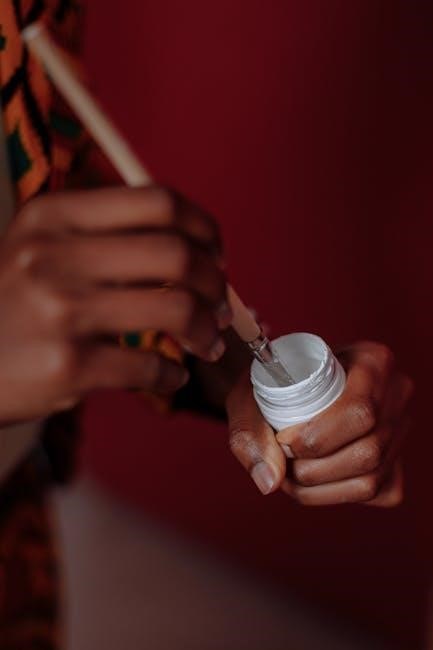Welcome to the world of Dremel projects! Discover how versatile and user-friendly Dremel tools are for crafting, carving, and creating unique DIY designs. Perfect for beginners, these projects offer endless creativity and practical applications, making them an excellent starting point for your creative journey.
What is a Dremel?
A Dremel is a versatile power tool known for its precision and adaptability in various crafting and DIY projects. It is widely used for tasks such as carving, cutting, engraving, and polishing materials like wood, metal, stone, and glass. The tool’s compact design and interchangeable attachments make it ideal for detailed work. Dremel offers multiple speed settings, allowing users to adjust power based on the material and project. Its portability and ease of use make it a favorite among hobbyists and professionals alike. Whether you’re a beginner or an experienced crafter, a Dremel opens up endless possibilities for creative and practical projects.
Why Dremel Projects are Perfect for Beginners
Dremel projects are ideal for beginners due to their simplicity, versatility, and rewarding results. The tool’s user-friendly design makes it easy to handle, even for those new to DIY crafting. Projects range from basic tasks like sanding and engraving to more complex creations, allowing learners to gradually build skills. The affordability and accessibility of Dremel tools also make them a great starting point for hobbyists. Additionally, the immediate feedback from seeing your work transform motivates beginners to keep exploring. With minimal space and equipment required, Dremel projects offer a fun and creative way to dive into the world of DIY without overwhelming commitments.
Essential Tools and Materials Needed
To get started with Dremel projects, you’ll need a few essential tools and materials. A Dremel rotary tool is the cornerstone, along with a variety of attachments like cutting wheels, sanding drums, and engraving bits. Safety gear such as safety glasses and a dust mask is crucial to protect yourself while working. A stable workspace with clamps or a vice will help keep your project steady. Additional materials like scrap wood, metal, or plastic for practice are also recommended. Don’t forget a power source and proper ventilation to ensure a safe and efficient workflow. Having these basics ready will set you up for success in your Dremel journey.
Getting Started with Your Dremel
Unpack your Dremel, explore its attachments, and set up a safe workspace. Start with simple projects to build confidence and familiarity with the tool’s versatility.
Understanding Dremel Attachments and Accessories
Dremel tools come with a wide variety of attachments and accessories designed for specific tasks. Cutting wheels are ideal for slicing through metal or plastic, while sanding drums smooth surfaces. Engraving bits allow for detailed designs, and polishing pads bring materials to a shine. Each attachment serves a unique purpose, and selecting the right one ensures precision and safety. Familiarizing yourself with these accessories will help you tackle projects efficiently. Always refer to the Dremel guide for compatibility and usage tips, as proper attachment selection is key to achieving desired results and maintaining tool performance.
Setting Up Your Workspace
Setting up a well-organized workspace is crucial for safe and effective Dremel projects. Start by clearing a sturdy, flat surface and ensuring good lighting to see your work clearly. Use clamps or a vice to secure your material, preventing movement during operation. Keep essential tools and attachments within easy reach to avoid distractions. Proper ventilation is key to avoid inhaling dust or particles. Store Dremel bits and accessories in a designated container to maintain order. Safety gear, such as goggles and gloves, should always be nearby. Lastly, have scrap material available for practice runs to refine your skills before working on your final project.
Safety Precautions

Safety is paramount when working with a Dremel. Always wear safety goggles to protect your eyes from debris, and consider gloves for better grip and protection. Tie back long hair and avoid loose jewelry that could get caught. Ensure your workspace is well-ventilated to prevent inhaling dust or fumes. Keep children and pets away while operating the tool. Maintain a firm grip on the Dremel and avoid overreaching. Never touch the bit while it’s spinning, and unplug the tool when changing attachments or not in use. Follow the manufacturer’s guidelines for speed settings and bit usage to avoid accidents.

Popular Dremel Projects for Beginners
Explore exciting Dremel projects like engraving, carving, cutting, sanding, polishing, DIY home decor, jewelry making, woodworking, and stone/glass crafting. These projects inspire creativity and skill development.
Engraving and Etching
Engraving and etching are excellent ways to personalize items like metal, wood, and glass. Using a Dremel, you can create intricate designs or text with precision. Start by selecting the right bit—diamond bits work best for etching. Practice on scrap material to get a feel for the tool’s speed and pressure. Lightly trace your design, gradually increasing depth as needed. Safety gear like gloves and goggles is essential. With patience, you can achieve professional-looking results, making unique gifts or customizing everyday objects. This skill opens up a world of creative possibilities for beginners.
Carving and Shaping
Carving and shaping with a Dremel is a great way to bring your creative ideas to life. Perfect for working with wood, plastic, or soft metals, the tool’s high-speed rotation allows for smooth, precise cuts. Start by using high-speed cutters or carving bits to remove material, then switch to sanding drums for smoothing edges. Always wear safety goggles and work in a well-ventilated area. Practice on scrap material to master control and technique. With patience, you can create intricate designs or functional items like custom knobs or decorative figurines. Carving and shaping are excellent skills for beginners to build confidence in their Dremel abilities.
Cutting and Sanding
Cutting and sanding are essential skills for any Dremel user. The tool’s versatility shines in these tasks, allowing precise cuts and smooth finishes. Use cutting wheels for slicing through metal pipes or plastic, while sanding drums and bands are perfect for smoothing rough edges or preparing surfaces. Always maintain steady control and work at the right speed to avoid overheating materials. Sanding attachments are also great for polishing wood or removing old paint. Start with lighter grits for coarse work and progress to finer grits for a polished finish. These techniques are fundamental for preparing materials for more complex projects, making them a must-learn for beginners.

Polishing and Buffing
Polishing and buffing are key techniques for achieving a professional finish in your Dremel projects. These processes refine surfaces, removing imperfections and enhancing material lustre. Use buffing wheels with polishing compounds for metals, plastics, or stone, while felt wheels are ideal for delicate surfaces. Start with lower speeds to avoid overheating materials and gradually increase as needed. Safety is crucial—always wear protective eyewear and maintain control. Regularly cleaning and replacing worn-out attachments ensures optimal results. With practice, you’ll master the art of transforming rough edges into polished masterpieces, making your creations stand out. This skill opens up endless possibilities for customizing and perfecting your DIY projects.
DIY Home Decor Projects
Transform your living space with unique DIY home decor projects using your Dremel. From engraved wall art to customized candle holders, you can craft personalized items that reflect your style. Use various attachments to carve intricate designs into wood, etch glass, or polish metal. Create functional pieces like custom coat racks or decorative coasters. With a Dremel, you can upcycle old items, turning them into stunning centerpieces. These projects are perfect for beginners, allowing you to explore creativity while enhancing your home’s aesthetic. Whether it’s a small detail or a statement piece, your Dremel helps bring your vision to life, making your space truly special.
Custom Jewelry Making
Unleash your creativity with custom jewelry making using your Dremel. This versatile tool allows you to shape, polish, and engrave various materials like beads, stones, and metals. Beginners can craft unique pendants, earrings, and bracelets by cutting and sanding small components. Use the Dremel to drill precise holes or smooth rough edges for a professional finish. Etch personalized messages or intricate designs onto metal or glass for a touch of elegance. With the right attachments, you can transform simple findings into stunning, one-of-a-kind jewelry pieces. This project is ideal for those who enjoy detail-oriented crafts and want to create personalized accessories or thoughtful gifts.
Woodworking Basics
Woodworking basics with a Dremel offer an excellent introduction to crafting intricate designs and shapes in wood. Beginners can learn to carve, cut, and polish wooden pieces with ease. The Dremel’s precision makes it ideal for detailed work, such as creating decorative patterns or smoothing edges. Start with simple projects like carving small figurines or engraving personalized messages. Use attachments like sanding drums to achieve a smooth finish. Practice on scrap wood to build confidence and skill. With patience, you can create beautiful wooden items like custom signs, decorative boxes, or artistic designs. This project is perfect for those who enjoy working with wood and want to explore its creative possibilities.
Stone and Glass Crafting
Stone and glass crafting with a Dremel is a fascinating way to create unique, durable designs. Beginners can learn to carve, engrave, and polish stone or glass surfaces with precision. Use diamond-tipped bits for etching intricate patterns or shaping stones; For glass, attach a grinding stone or sanding drum to smooth edges or create decorative finishes. Safety is key—always wear goggles and a dust mask when working with these materials. Start with simple projects like engraved jewelry, decorative coasters, or personalized glassware. With practice, you can achieve professional-looking results, transforming raw materials into stunning pieces of art that showcase your creativity and skill.
Metalworking Fundamentals
Metalworking with a Dremel offers endless possibilities for shaping, cutting, and polishing metal. Start by using cutting wheels to slice through thin metal sheets or pipes. For smoothing rough edges, attach a sanding drum or flap wheel. Engraving tools allow you to add intricate designs or text to metal surfaces. Begin with small projects like custom keychains, decorative labels, or jewelry. Always wear safety goggles and work in a well-ventilated area. As you gain confidence, experiment with more complex tasks like creating metal art or repairing tools. With patience and practice, you can master the basics of metalworking and unlock a world of creative possibilities.

Tips for Success
Mastering Dremel projects requires patience and practice. Start with scrap material to refine techniques and ensure safety. Follow online tutorials for guidance and inspiration. Always choose the right attachments and speeds for your tasks to achieve professional results. Keep your workspace organized and well-lit to maintain focus and efficiency. Experiment with different materials gradually, and don’t hesitate to seek advice from experienced makers. With persistence, you’ll unlock endless creative possibilities and enjoy the satisfaction of bringing your ideas to life.
Choosing the Right Speed and Attachment
Selecting the appropriate speed and attachment is crucial for successful Dremel projects. Begin by understanding the tool’s variable speed settings, typically ranging from 5,000 to 35,000 RPM. Lower speeds are ideal for cutting and carving, while higher speeds suit sanding and polishing. Familiarize yourself with attachments like cutting wheels, sanding drums, and engraving bits. Each attachment serves a specific purpose, so match it to your task. Always refer to the Dremel’s user manual for recommendations. Experimenting with scrap material helps determine the best settings for different materials. Proper speed and attachment selection enhances precision, safety, and overall project quality. Practice makes perfect, so take your time to explore various combinations.
Practicing on Scrap Material
Practicing on scrap material is essential for mastering Dremel techniques. It allows you to experiment with different speeds, attachments, and material types without risking damage to your final project. Start by testing cuts, carvings, and sanding on inexpensive or leftover materials like wood, metal, or plastic. This hands-on practice helps you understand how the Dremel behaves and how to control it effectively. Use scrap pieces to refine your skills, observe how materials react, and adjust your approach as needed. Keeping scrap materials on hand ensures you can try new techniques confidently. Remember, practice is key to achieving professional-looking results and avoiding costly mistakes. Be patient, as improvement comes with time and repetition.
Following Online Tutorials
Following online tutorials is a fantastic way to learn Dremel techniques and gain confidence as a beginner. Many websites and YouTube channels offer step-by-step guides for various projects, from carving and engraving to cutting and polishing. These tutorials often include video demonstrations, making it easier to understand complex processes. They also provide tips for choosing the right attachments and setting the correct speeds. By following these guides, you can explore different materials and techniques without feeling overwhelmed. Additionally, online communities and forums share project ideas and troubleshooting advice. Start with simple projects and gradually move to more complex ones as your skills improve. This approach ensures a smooth learning curve and helps you master your Dremel tool effectively.
With a Dremel tool, the possibilities for creativity and DIY projects are endless, even for beginners. By starting with simple tasks like engraving or sanding, you can gradually master more complex techniques. The key to success lies in practicing regularly, using the right attachments, and following safety guidelines. Online tutorials and guides are invaluable resources to help you improve your skills. As you gain confidence, you’ll unlock new ways to transform materials like wood, metal, and stone into unique creations. Remember, every project is an opportunity to learn and grow. Embrace the versatility of your Dremel and enjoy the satisfaction of crafting something with your own hands.